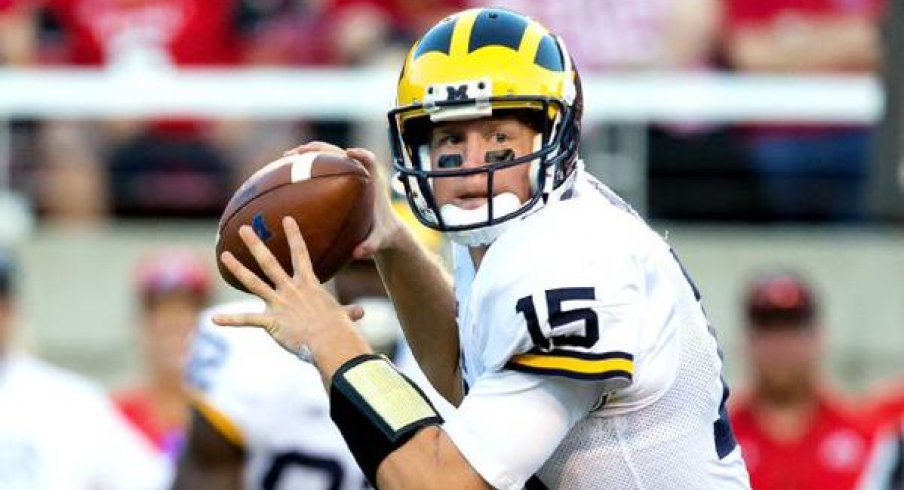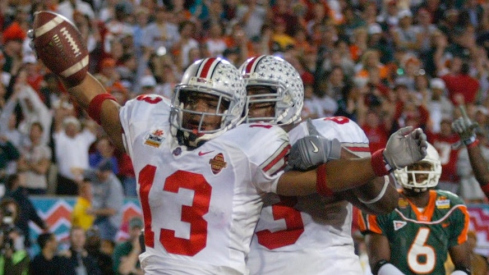Get ready Buckeye fans. The Michigan offense has been reinvigorated and is hitting its stride under first-year head coach Jim Harbaugh.
Under legendary head coach Bo Schembechler, the “Michigan way” was synonymous with pro-style personnel, physicality in the run game, and a play action-based passing game. The tradition continued under former head coaches Gary Moeller and Lloyd Carr, only to be scrapped with the hiring of Rich Rodriguez, who radically transformed the Michigan program with his zone-option offense that looked to spread out the defense, empty the box to run the ball, and throw the ball to wide receivers in space. With the failure of former head coach Brady Hoke to return the Michigan offense to its pre-Rodriquez roots, Michigan pinned its hope on current coach Jim Harbaugh to complete the transformation back to the “Michigan way”.
Harbaugh has made a habit of taking over struggling teams and producing quick turnarounds, starting with the University of San Diego before transforming a woeful Standard squad into a Pac-12 powerhouse. After jumping to the NFL to lead the San Francisco 49ers to three-straight playoff appearances, Harbaugh moved back to the college ranks to take over the Wolverines this past offseason. Harbaugh’s offensive philosophy and scheme has produced fast results for the Michigan program, currently 9-2 and entering the Ohio State game with an outside shot at the Big Ten East title.
Behind Harbaugh’s well-known brash personality and idiosyncrasies is a masterful offensive coach with a proven offensive scheme that aligns hand in glove with the “Michigan way.” Although Harbaugh has adapted his scheme to integrate current trends like zone-running, jet sweeps, and bubble/flash screens, at its core Harbaugh’s offense is built around heavy pro-style personnel, motion/shifts, a gap-based run game, and a West Coast offense passing attack.
Over the years the West Coast offense has been used to describe an offensive philosophy, formations, a set of passing concepts, and even the verbiage used to make a play call. Legendary head coach Bill Walsh, often considered the godfather of the West Coast offense, perfected the philosophy on his way to three Super Bowl victories with the San Francisco 49ers. Disciples of the philosophy can be found up and down the NFL and college ranks, including Mike McCarthy (Green Bay), Andy Reid (Kansas City), and Lane Kiffen (Alabama).
Although the system has evolved and integrated with various offensive systems over the previous three decades, the traditional West Coast offense looks to set up the run by passing first, with an emphasis on horizontal stretches across the field. A variety of three-step concepts and routes are used to get the ball out of the quarterback’s hands quickly. Targeted vertical shots are taking as the defense is continuously stretched across the length of the field, opening up the downfield passing game.
Although viewed as a run-heavy team, Michigan has averaged 30.6 passing attempt per game this season. Harbaugh has leaned on his West Coast, play action passing attack to produce yards and points due to inconsistent running back play, injuries, and quarterback Jake Rudock’s ability to spread the ball around to a variety of wide receivers, tight ends, and running backs. In Michigan’s 49-16 dismantling of Rutgers, Rudock completed passes to 10 different receivers, highlighting his ability to play within Harbaugh’s system and find open receivers.
A quick viewing of Michigan’s 2015 film reveals numerous examples of classic West Coast passing concepts, starting with Dragon, otherwise known as the slant/flat. Focus on the tight end and wide receiver at the bottom of the screen.

The slant/flat read is relatively simple for the quarterback as he will read the flat defender, in this case the weak-side linebacker (WILL) aligned over the tight end. If the flat defender widens with the flat route, throw the slant. If the flat defender attempts to undercut the slant route, throw the flat. Because the WILL immediately carries the tight end to the flat, the slant route is the read here.

Another West Coast staple that shows up on Michigan film is the famous curl/flat combination, or Hank in West Coast verbiage, a concept run at all levels of football.

The quarterback is reading #48, located over and above the tight end. If the defender widens with the flat route, Rudock will throw the curl. If #48 gains depth (moves backwards) to cushion the curl route, Rudock will throw the flat route. Because the defender widens with the flat route, the curl route is able to slip inside the defender for an easy pitch-and-catch.

A Harbaugh favorite that will look familiar to Buckeye fans is the Smash, or China concept. Michigan will dress up the concept by running it from a variety of alignments, formations, and personnel groupings, but the principal and reads remain the same. Offensive coordinator Tim Drevno showed creativity running the concept out of a stacked alignment (bottom of the screen) in Michigan’s 49-16 dismantling of Rutgers.

A classic Cover-2 beater, smash features a short route (usually a hitch) from the outside receiver, with the inside receiver running a corner route. The route concept puts the cornerback in a hi-lo bind. The quarterback will throw the hitch route if the defender gains depth to play the corner route, or the corner route if the defender jumps the hitch route. The cornerback is put in a “heads I win, tails you lose” situation due to a Cover-2 weakness along the deep sideline.

In the clip above the concept is run from the stack alignment as a man-beater, taking advantage of the rules the defense uses to determine which defender covers which receiver. The defender tasked with guarding the first receiver to break inside is put in a tough spot as he is forced to cover an outside-breaking route from the inside part of the field. Look closely at #37 (bottom-left of the clip). Notice his alignment over the inside shoulder of the wide receiver running the corner route. This inside alignment, or leverage, creates more distance for the defender to cover to make a play on the ball.
Another familiar West Coast concept that shows up on film is the Snag/Spot concept. Wide receiver Braxton Miller snagged the first of his two touchdowns against Virginia Tech off the play, running the corner route against man coverage.


In Michigan’s week four thrashing of BYU, Rudock found leading receiver Amara Darboh (#82) on the snag route as his defender was unable to navigate traffic at the goal line for an easy touchdown.

The tight end position has always played an important role in Harbaugh’s offense. 6-foot-6, 248-pound junior tight end Jake Butt is Michigan’s second-leading receiver on the season, totaling 43 receptions and averaging a gaudy 13.2 yards per reception. The Pickerington North graduate is likely the most dangerous tight end the Buckeye defense has faced this season due to his size, speed, crisp route-running, and good hands.
Butt’s 2015 game film is full of receptions made off classic West Coast passing concepts. Against Penn State, Butt used his quick feet and strength to turn a four-yard reception into a nine-yard gain off the all-hitches, or spacing concept.


Notice the short routes run by the wide receivers and tight end. The spacing concept is designed to horizontally stretch a defense across the field, leaving a hole for the pass-catcher to sit down in. The play is usually read inside-to-out, making Butt the first read in the quarterback’s progression. What sets this play apart is Butt’s ability to make defenders miss in the open field and use his strength to gain 3 yards after contact
Harbaugh will use his run game to set up several play action concepts throughout the course of a contest. Michigan’s go-to play action concept is Y-cross, a three-level stretch or OVS (Outside Vertical Stretch) that features a clear out route by the outside receiver, a crossing route (often by the tight end), and a flat route.

Butt will run both the flat and crossing route in this play action concept. In the clip below, Butt again demonstrates his open field running ability and strength, turning a short pass into a first down through a combination of good feet and yards after contact.

There is no magic formula to stopping a West Coast passing attack, so how does the Ohio State defense slow down a peaking Michigan offense averaging over 30 points-per-game?
The first step occurs behind the scenes, as the defense prepares via film study and practice reps for the variety of alignments, personnel, and motion/shifts the Wolverines will utilize. Formation recognition and communication are vital to the defense’s ability to adjust on the fly, as Michigan will often change the strength of the offensive formation at the line of scrimmage.
Focus on the front seven this Saturday. Are the linebackers and defensive line bumping to the strength of the Michigan formation as motion and shifts occur? Are they realigning with enough time to reset and get their eyes back on their run/pass keys?


In both clips above, notice how quickly the defensive line and linebackers adjust their alignment to motion. While the bumps may look minor, they are vital to ensuring that all defenders are in position to play their assigned gaps, or fits, in the run game. These run fits prevent the defense from being outnumbered at the point of attack, a Harbaugh staple.
Michigan will look to target wide receivers, tight ends, and running backs off play action several times this Saturday. Buckeye defenders must practice good eye discipline by quickly reading their run/pass keys to avoid getting out of position. Quick, accurate key reading will limit the Wolverine’s ability to hit Butt in the passing game and create chunk gains downfield.


If the Buckeyes hope to extend a three-game winning streak against the Wolverines, the defense must play fast, disciplined football to slow down Harbaugh’s unique attack. While the Buckeyes have not seen a West Coast-based passing attack this year, the unit has the scheme and players to limit Michigan’s success on offense. In a matchup of two quality football teams, the outcome usually hinges on four or five key plays. Who will make the plays this Saturday?
Make a turkey sandwich, open your favorite (adult) beverage, and tune in at high noon. Like Christmas, the Ohio State-Michigan game comes but once a year.


